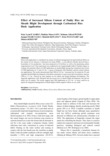Effect of Increased Silicon Content of Paddy Rice on Sheath Blight Development through Carbonized Rice Husk Application
| ISSN | 00213551 |
|---|---|
| 書誌レコードID(総合目録DB) | AA0068709X |

Silicon (Si) application is considered one means of cultural management having beneficial effects on the control of rice diseases. Carbonized rice husk (CRH)—a cost-effective biochar derived from a by-product of rice production—has been proposed as Si fertilizer as well as for promoting carbon sequestration in soil. This experiment was conducted in an irrigated paddy field in Tsukuba, Japan to evaluate the potential effects of CRH application on sheath blight among four treatments (two levels of CRH application at 1.5 and 3.0 t ha–1, a spray of fungicide with flutolanil, and the control without any application). The results demonstrated that CRH at 3.0 t ha–1 increased rice Si content by 9% and regulated sheath blight development in the plant community to some extent after inoculation, whereas CRH at 1.5 t ha–1 showed no clear impacts on rice plants and fungal pathogen development. The fungicide application with flutolanil had the lowest rate of sheath blight development, but did not affect rice Si content. The results suggest that CRH application at 3.0 t ha–1 or more could be an option for integrated management of sheath blight without negative effects on rice yield.
| 刊行年月日 | |
|---|---|
| 作成者 | Peter Lyod P. SABES Mathias Mawo LON Mchuno Alfred PETER Jumpei MARUYAMA Shinichi KOYAMA Tetsu WATANABE Shinzo KOIZUMI |
| 著者キーワード |
biochar silicon Oryza sativa Rhizoctonia solani yield |
| 公開者 | Japan International Research Center for Agricultural Sciences |
| 受付日 | 2019-04-05 |
| 受理日 | 2019-09-19 |
| オンライン掲載日 | |
| 巻 | 54 |
| 号 | 2 |
| 開始ページ | 145 |
| 終了ページ | 151 |
| DOI | 10.6090/jarq.54.145 |
| 言語 | eng |
